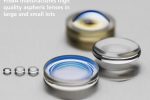FISBA’s laser module is compact, precise and reliable. Since half a decade it has been in continuous service in more than 10,000 plate setters for industrial offset printing machines around the world. Every two micro-seconds, each of its 64 individually controllable diode lasers shapes a pixel on the printing plate. The version designed for biotechnology uses the beams of light in a more sensitive way: As laser tweezers, they arrange molecules, cell fragments and particles inside a microfluidic system.
«This laser module helps to speed up the execution of biochemical studies, for example in pharmaceutical drug discovery processes or while testing flavoring substances in the food industry», explains René Salathé from the École polytechnique fédérale de Lausanne (EPFL), where the subassembly was tested in a new miniaturized analytical system. «Using multiple laser tweezers enables to trap and investigate cells, cell fragments and beads in a highly parallel manner».
«Lab-on-a-chip applications have an extremely compact design and present an efficient and more flexible alternative to microtiter plate procedures», says Urs Schneider from FISBA in St. Gallen, where the laser module was designed and assembled. «In order to achieve a high throughput, we used an array of 64 individually controllable diode lasers with micro optics capable of generating precise spotlights of only 10µm in diameter. They allow for examining, sorting and aligning of single particles at high speed», he adds.
Intended for use in stand-alone applications and microscope systems featuring fluorescence excitation, the system can be equipped with any number of individually addressable laser tweezers. It allows for parallel and interactive analyzing and manipulating of particles in a micro-fluidic reaction chamber. Thereby a very small solution quantity of only 0.5 µL is required at a flow rate of 0,008µL/s in the current design.


